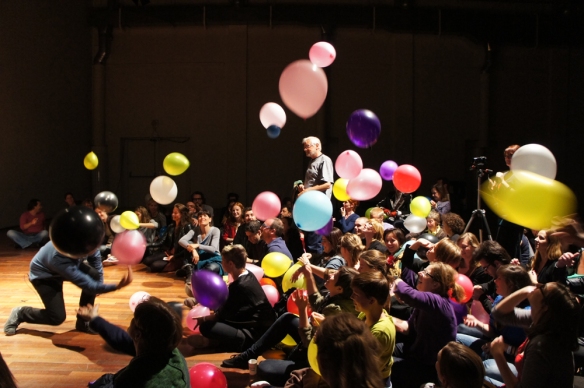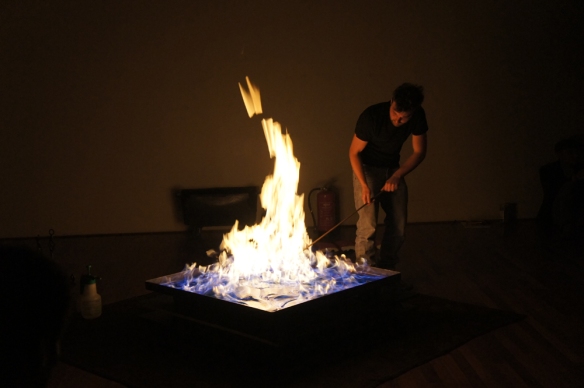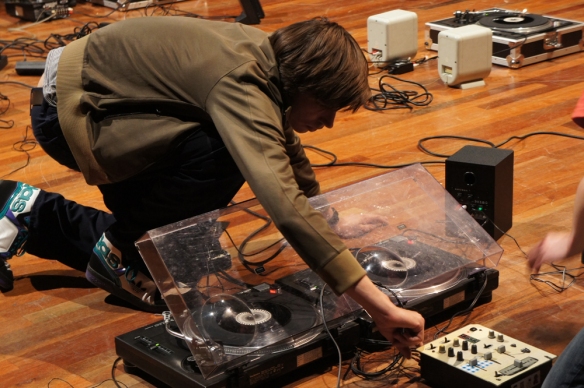Lots of crisis in the wind, but it wasn’t the vibe this weekend in Amsterdam.
The organizers of Performance Art Event (PAE) hosted an evening at the Brakke Grond last week, which begin with criticism and an open ended question. According to organizers, ‘The creative arts sector is worried about the crisis and its impact on the arts. The more crises, the more performance is an expression of the growing awareness of this tendency. Live art doesn’t need much, it can take place always and everywhere, and especially in a period of crisis this could evoke a renewed interest in performance art. Could this mean that more artists will turn to performance art, leading to a revival of the genre?’
The question led me to ask myself if there was a crisis in performance art. There must be. Generally, besides tickets, there is nothing for sale. That Performance Art has earned its place in history is undeniable and referenced in the creation of radical fractures that wounded certain culture norms. Equally undeniable is the difficult fight the genre has in front of it as subsidies get slashed and its artists tip toe or stomp around the market, staying aware of the jaws of consumption. Suddenly I’m a bit ashamed that I got in with a press pass. This was quality entertainment and sensual provocation. It was sweet. It was violent. It was brave. I would have happily paid to see it.
Even Marina Abramovic was present. From the nod to her in the show’s title, to the two acclaimed critics who brought up her name no less than 5 times between them, Marina Abramovic’s head was used as a call for attention and her quotes appeared as bodyguards. With next to nothing on sale and a series of physically grueling performances, it appeared as a smart plea at a time that saw the city saturated with cultural events that linked in one form or another to standard discussions of the market.
Whether it was this subtle promotional meme or something rooted in PAE’s history, the call for attention worked. There was a large and engaged audience, a hall full of buzzing people. After a day of observing art in semi tailored pre-fabricated white boxes at the fair, this exhibition seemed to take place in a sort of gymnasium, which I found refreshing. I wanted to put on my gym shorts and shoot hoops. It was spacious, open naked, free and had a smooth floor. Nina Boas, one of the shows curators and founders of Performance Art Events, told me she’d envisioned an exhibition that visitors could travel through, taking a journey in an empty space that does not change. She nailed it. We started off asked to grab a seat. There were some ‘mobile’ chairs for those who needed them. Everybody else just got comfy on the ground and gathered around Abner Preis who gave a performance that resulted in a piece of art created by the entire crowd. ‘I’ll teach you how to make art and we’ll create a piece together,’ he told us. It was a perfect forward to what the audience would experience after: spiritual trips that were only comprehensible through a mixture of emotional, sensual, intuitive and signified analytic reactions.
Performance Art is rather militant. It is art, because the artist declares it as such. It does not often feel the need to defend itself (though the interjection of the two very passionate speakers who championed the medium between performances damaged this claim). Performance art has been linked to the avant-garde consistently since 1910, but only became known as such in the 1960’s. It can be entertaining, amusing, shocking or horrifying, but no matter how you define it, its aim is to be memorable. This vanguard line, cutting from the turn of the century right through Dada and Surrealists and thank god through the deconstructed heart of post-modernism had continuity here as each of the performances demonstrated a commitment to experimentation that pushed boundaries and challenged status quo conversations about art and what actually constitutes a crisis. On this occasion, there was no crisis in craft.
Of the six performances, four will stay with me for quit some time. Some of these were rough physical ordeals that could reference those that Marina Abramovic has endured to explore themes like trust, fortitude, exhaustion and departure.
That said, we won’t bring her up again and can do what I wish the two critics would have, taking good old Marina’s head out of the basketball hoop to let the other performers onto the stage. Once attention shifted to the performers themselves, they polished the floors with oil and fire, broken glass and explosives, played TV blues that result in loss of linguistic skills and dropped a 1000 beats so precisely that they drowned into a circle. The night concluded with a gutsy performance, a heart breaking, knee slapping and rather disgusting sort of sweet declaration from Renée van Trier that could have been a serenade to the entire evening.
Each piece drew me in with a different language, but one managed to hypnotize me. When Isabelle Schiltz stopped her performance, I am not sure if it was 10, 30, or 300 seconds before people recognized an end and began to applaud. I am not sure if it was she who stopped or the audience. Who was in control? I was lost in the silence, the now dark screen and her silhouette. I was still staring. She did not move. The room rotated again and the crowd turned its back, but for a good ten minutes she sat there. I wondered where she’d gone and could almost feel inklings of what the performance had demanded of her or where she might have escaped to.
As a user called ‘TheRev’ posted on Trendbeheer.com the day after the event coverage first came up: ‘explosions, fire, music, shit, great times.’
Great times, Great Artists, Great Project and for anybody who wants to know what’s going on in contemporary art today, this event offered a window to what was missing from Art Amsterdam.




